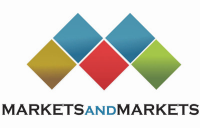The Pharmaceutical Robots Market Is Projected to Reach USD 119.5 Million by 2021
[141 Pages Report]Pharmaceutical Robots Market report categories the global market Application (Picking and Packaging, Laboratory Applications), Type (Traditional Robots (Articulated Robots, SCARA Robots, Delta Robots, Cartesian Robots), Collaborative Robots) & Geography.

Seattle, WA -- (SBWire) -- 07/11/2017 --The report "Pharmaceutical Robots Market by Type (Traditional Robots (Articulated Robots, SCARA Robots, Delta Robots, Cartesian Robots), Collaborative Robots), Application (Picking and Packaging, Laboratory Applications) - Global Forecast to 2021", analyzes and studies the major market drivers, restraints, opportunities, and challenges.
Browse 98 market data tables and 40 figures spread through 141 pages and in-depth TOC on "Pharmaceutical Robots Market by Type (Traditional Robots (Articulated Robots, SCARA Robots, Delta Robots, Cartesian Robots), Collaborative Robots), Application (Picking and Packaging, Laboratory Applications) - Global Forecast to 2021"
This report studies the global pharmaceutical robots market for the forecast period of 2016 to 2021. This market is expected to reach USD 119.5 Million by 2021 from USD 64.4 Million in 2016, at a CAGR of 13.2% during the forecast period. The key factor driving the growth of the market is the benefits offered by robotic systems in pharmaceutical manufacturing.
For More Information, Request PDF Brochure : Click Here
The global pharmaceutical robots market is segmented on the basis of type, application, and region.
Based on type, the market is segmented into traditional robots and collaborative robots. The traditional robots segment is expected to command the largest share of the global market. The traditional robots segment is further categorized into articulated, SCARA (selective compliance articulated robot arm), delta/parallel, Cartesian, and other robots (which include spherical and dual-arm robots). The articulated robots segment accounted for the largest share of the global pharmaceutical traditional robots market in 2016.
On the basis of application, the global pharmaceutical robots market is segmented into picking and packaging, inspection of pharmaceutical drugs, and laboratory applications. In 2016, the picking and packaging segment accounted for the largest share of the global pharmaceutical robots market. Factors such as demand for personalized packaging configurations and advantages of robots in pharmaceutical manufacturing such as high speed, accuracy, ability to track and trace, error-free operation, fewer accidents, and better utilization of the floor space are contributing to the large share of the picking and packaging segment.
Based on region, the pharmaceutical robots market is divided into North America, Europe, Asia-Pacific, and the Rest of the World. In 2016, Asia-Pacific accounted for the largest share of the global market. This segment is also projected to register the highest CAGR of 14.1% during the forecast period. Factors such as the increase in domestic industrial robot companies, flourishing pharmaceutical industry, increasing number of conferences and exhibitions, investment and funding in the robots industry, and Japan's Robot Strategy are driving the growth of the APAC pharmaceutical robots market.
Kawasaki Heavy Industries Ltd. (Japan), FANUC Corporation (Japan), KUKA AG (Germany), Mitsubishi Electric Corporation (Japan), ABB Ltd. (Switzerland), Denso Corporation (Japan), Seiko Epson Corporation (Japan), Marchesini Group S.p.A (Italy), Universal Robots A/S (Denmark), Yaskawa Electric Corporation (Japan), and Shibuya Corporation (Japan) are the prominent players in the global pharmaceutical robots market.
Media Relations Contact
Mr. Rohan
1-888-600-6441
http://www.marketsandmarkets.com
View this press release online at: http://rwire.com/830613